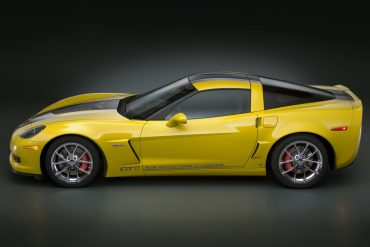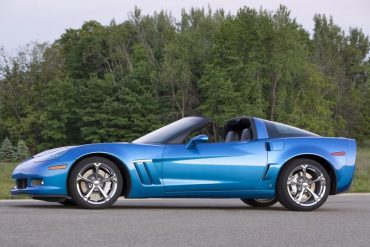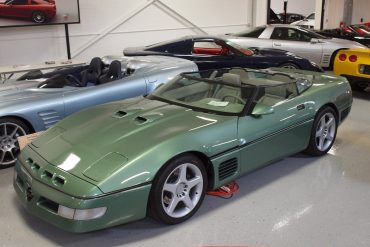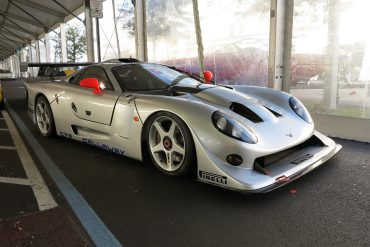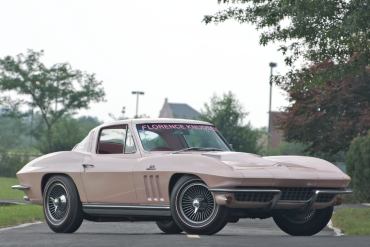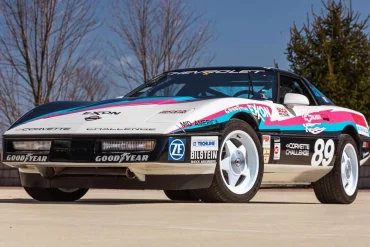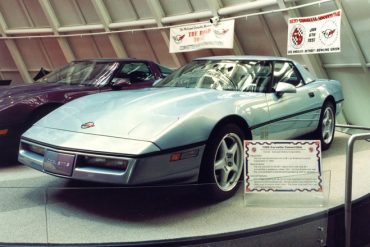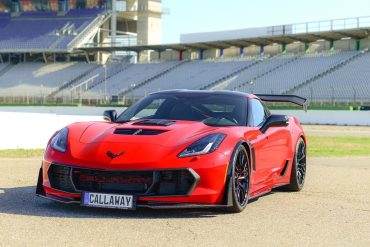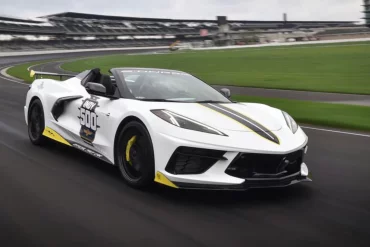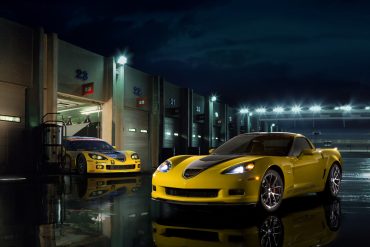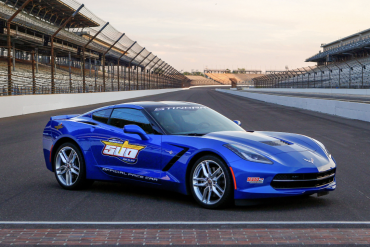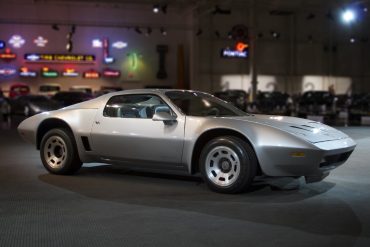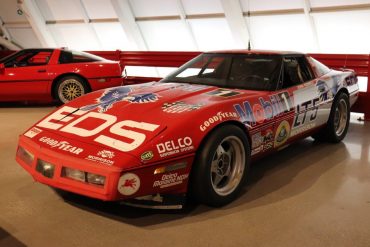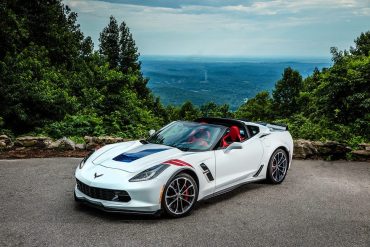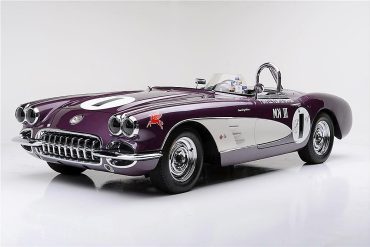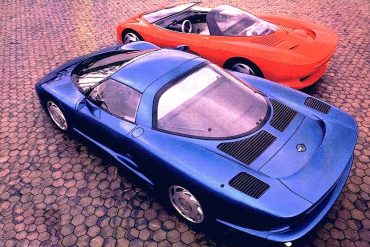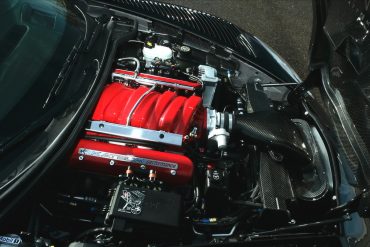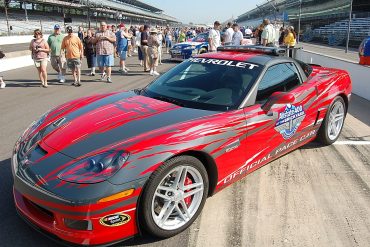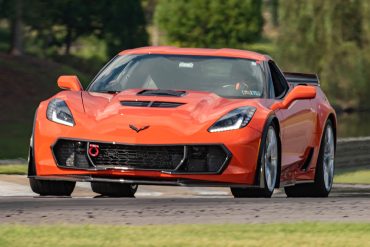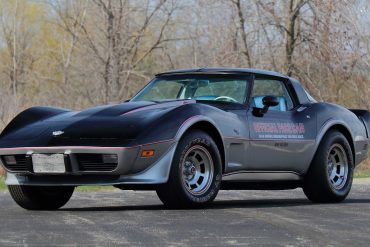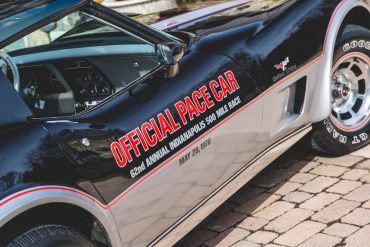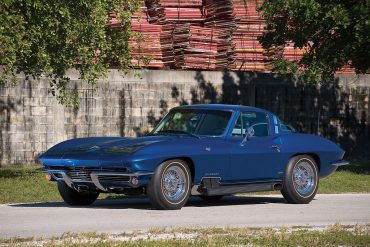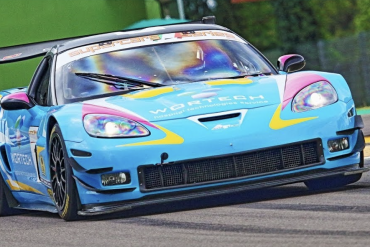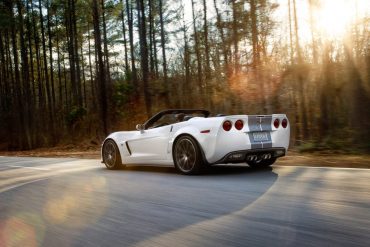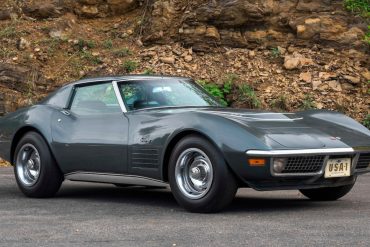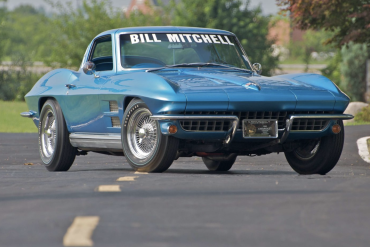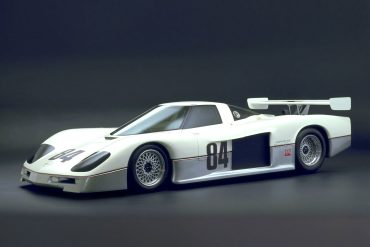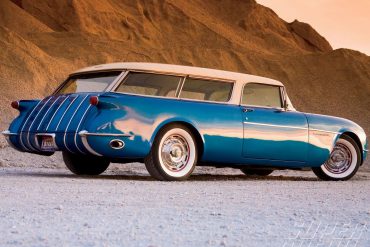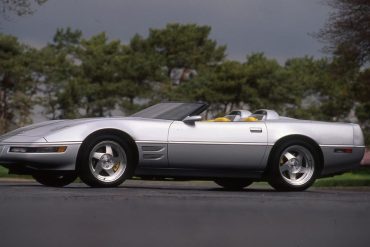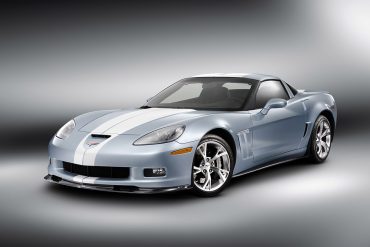Chevrolet introduced the limited production Corvette GT1 Championship Edition at Sebring International Raceway. The GT1 Championship Edition (Regular Production Option GT1) commemorates the success of Corvette Racing and the Corvette C6R:
The 2010 Grand Sport Corvette was introduced to the world at the 12th annual C5/C6 Corvette Birthday Bash, which was (and is) held at the National Corvette Museum in Bowling Green, Kentucky. During its unveiling, it was announced that the new Grand Sport would be offered as either a coupe or a convertible, and it would feature an appealing combination of the LS3 power plant fused with the Z06 Corvette’s wide track chassis and styling features.
In 1989 Callaway introduced a Speedster which was the culmination of their styling, engineering and trimming talents. Their first example was a bright green ZR1, which had a severely chopped windscreen, no side mirrors, eighteen inch wheels and a vibrant blue leather interior stitched purposefully from Germany. Nothing about Callaway’s Speedster was reserved, and this is especially true when investigating the specification. The car had 450 horsepower.
The Callaway C7 was a completely new, purpose-built car designed to embody the company’s motto: “Powerfully Engineered Automobiles”, carrying on the visual tradition of design by Paul Deutschman and offered in a limited production series. The C7 was the first complete, bespoke Callaway Automobile. This sportscar was equipped with a carbon chassis, front mid engine/rear transaxle design, 650 horsepower SuperNatural engine.
"Bunkie" Knudsen ordered it up in the spring of 1964 for his wife, Florence. This car is as much of a gem today as it was when Florence Knudsen first saw it, so says its current owner, Chevy dealer and noted Corvette collector Bob McDorman. It had custom Pink Pearl paint and custom pink leather interior.
The 1989 Corvette Challenge cars had a unique option code from the factory, it was "R7F". The documentation from GM clearly indicates that the cars were produced for the express purpose of racing in the SCCA Corvette Challenge Series. There is also documentation that identifies by serial number, all Corvettes produced with these option codes. Therefore, it is relatively easy to validate the authenticity of any Challenge car.
There were several successful attempts to build a convertible ZR-1, most of them by private people. The DR-1 was a GM prototype to test the structural integrity of the ZR-1 chassis when it would be topless. The car was built by American Sunroof Corporation (ASC) for Don Runkle, who was the vice-president of Advanced Engineering Staff, which explains the “DR-1” designation. It was a standard convertible transformed to ZR-1 specs.
Callaway Competition has constructed some of the most successful GT3 race cars in history. Competing against the world’s premier marques, Callaway is currently recognized as the most successful race team of the ADAC GT Masters series. To celebrate Callaway Competition’s 25th anniversary, we’re building 25 unique, specially-equipped “Callaway Champion” road cars. The Z06-based Champions are built by our expert craftsmen.
The Chevrolet Corvette has served as the official pace car of the Indy 500 18 times since 1978. That accounts for half of the 32 times that Chevrolet has been given the honor since 1948, which only highlights the sports car’s endearing legacy. Interestingly enough, this C8 Corvette convertible is the first Indy 500 pace car to have a drop-top since the 2011 Chevrolet Camaro.
Chevrolet introduced the limited production Corvette GT1 Championship Edition at Sebring International Raceway. The GT1 Championship Edition (Regular Production Option GT1) commemorates the success of Corvette Racing and the Corvette C6R.
The all-new, seventh-generation 2014 Corvette Stingray served as the Indianapolis 500 Pace Car, leading the field to green at the start of the 97th running of “The Greatest Spectacle in Racing,” on Sunday, May 26 2013. It marked a record 12th time the Corvette served as the Pace Car, starting in 1978. Jim Harbaugh, head coach of the NFL’s San Francisco 49ers, drove the all-new 2014 Chevrolet Corvette Stingray Pace Car
The XP-895 was one in a series of experimental Corvettes built to explore alternative engine placements and chassis layouts. This vehicle features an 400 cid small block V8 mounted transversely in a mid-engine position. It utilizes a Turbo Hydramatic transmission via a bevel gear box. The body panels are all aluminum.
On March 1-2 1990 a unique group of people using a Chevrolet Corvette ZR-1, reset The 24-hour World Speed Record. That achievement proved unequivocally that the car is indeed...King of the Hill. "The 24" had stood for 50 years. Last set at Bonneville in 1940 by AP Jenkins driving the "Mormon Meteor Ill", a purpose-built. single-seat race car with an aircraft engine. The objectives: set the 24 as well as 5000 kilometer and the 5000 mile marks with a ZR-1 while using an L98-powered Corvette to set the six-hour record and other shorter distance marks.
The 2017 Chevrolet Corvette Grand Sport combines a lightweight architecture, a track-honed aerodynamics package, Michelin tires and a naturally aspirated engine to deliver exceptional performance. The Grand Sport Collector Edition features an exclusive Watkins Glen Gray Metallic exterior with Tension Blue hash-mark graphics, satin black full-length stripes and black wheels. the new Grand Sport combines a lightweight architecture.
The Purple People Eater MKIII is a 1959 Corvette that was literally unbeatable in SCCA B-Production racing in the late 1950s. There were three Purple People Eaters built in 1958 and 1959. The 1959 model, won every race it entered, except the last one, with Jim Jeffords behind the wheel and mechanic Ronnie Kaplan turning wrenches. The car was built by a team at Nickey Chevrolet in Chicago.
While it was understood that the Corvette Indy Concept would never be fully realized as a production vehicle, it paved the way for the creation of the twin-turbo CERV III. The CERV III (Chevrolet Engineering Research Vehicle No. 3) was introduced in January, 1990 at the International Auto Show in Detroit, Michigan. Like the latter iteration of the Corvette Indy Concept car, the CERV III was fitted with a 5.7 Liter, 32-valve, dual-overhead cam LT5 engine that featured twin turbochargers. It had 650 hp and 655 lb/ft of torque and top speed of 225 mph.
In 2006, the company behind the Corvette C6.R pulled out all the stops and developed a Corvette (based on a Z06 donor car and a lot of amazing engineering) that featured an unprecedented amount of horsepower and torque under its hood while packing ultimate luxury inside its ultra-wide carbon-fiber body. The car, which was revealed at the SEMA show in 2007, was called the C6RS Corvette.
2009 marked the 16th time that Chevrolet has paced the Allstate 400 at the Brickyard and the fifth consecutive time Corvette has led the pack. Chevrolet's pacing tradition at the Indianapolis Motor Speedway also extends to the Indianapolis 500 where Chevrolet has paced that esteemed race 20 times with Corvette leading the field 10 times.
For the 2014 model year, the Chevrolet team sculpted the seventh-generation Corvette into the most sophisticated, most feature-packed Corvette produced to date. Facing a daunting challenge, new technology enabled Callaway engineers to produce breathtaking power with seamless transition into and out of positive manifold pressure. Entirely new, Callaway’s patented GenThree supercharger design improved airflow quality and increased charge air cooling capacity.
While the redesign gave the Corvette a fresh look for the new model year, Chevrolet also recognized the importance of commemorating the car's quarter-century of production. For the first time in the brand's history, two special-edition Corvettes were introduced for the 1978 model year: the Silver Anniversary Edition and the Indy Pace Car coupes. On March 15, 1977, the 500,000th Corvette rolled off the assembly line at Chevrolet's St. Louis manufacturing plant.
1978 was significant because it marked the cars 25th anniversary of production. Recognizing the achievement of manufacturing a car for a quarter-century, Chevrolet commemorated this accomplishment by introducing two special-edition Corvette that year. The first of these was known as the "Silver Anniversary" edition Corvette. It featured a two-tone silver over gray exterior with special pin-striping and special "25th Anniversary" badging.
This one-off Corvette was custom-built by GM Styling under famed design chief Bill Mitchell, especially for the famed industrialist and Indianapolis racing sponsor Ozzie Olson of Olsonite fame. Among its special modifications including custom floor grates that were a trademark feature of the GM Styling specials
During the summer of 2005, a decision was made to transform selected Z06 road cars into a new breed of racer to compete in the world's top GT3 championships. The first series to introduce this new GT3 class was the SRO and FIA's GT3 Championship. Based on their racetrack test results, Team Carsport saw instant potential in the car. Hezemans contracted Callaway Competition in conjunction with Koos Pettinga, manager at Corvette Europe, to convert the street Z06 into a Z06R GT3.
The 2013 Corvette 427 Convertible served double-duty as a commemorative edition model. While it marked the departure of the sixth-generation Corvette. The real selling-point was the powerplant at the heart of the car - a 427-cubic-inch (7.0L) LS7 engine, the same engine used in the C6 Corvette Z06. Rated at 505 horsepower (377kW) and 470lb.-ft of torque (637 Nm), this 427 was the most powerful engine GM had ever installed in a production Corvette convertible to date.
Did you know that the earliest ZR1 Corvettes came into existence long before any of these later iterations? If not, then take a few minutes to acquaint yourself with one the rarest small-block production Corvettes of all time - the 1970-1972 Corvette ZR1. From 1970 to 1972, Chevrolet offered the ZR1 Special Engine Package, which featured a small-block LT1 engine.
The most innovative of the Bob McDorman Collection’s GM Styling Corvettes is this Blue Metallic one-off enjoyed by GM Styling legend Bill Mitchell. The unique paint is accented with a custom made die cast front grille and matching dual front fender vents. A willing 327 CI engine gave this gem all the performance the boss could have asked for...
A Corvette in name only, the Corvette GTP (Grand Touring Prototype) was one of the fastest and most exotic race cars ever to wear a red Bowtie. Based on an English Lola T600 chassis and powered by an all-American turbocharged Chevy V6, the mid-engined racer was a rocketship. At full boost, the Corvette GTP's 3.4-liter (209ci) V6 pumped out more than 1,000 horsepower.
Carl Renner was responsible for the Nomad which was essentially a Corvette built with an extended station wagon roof. This meant the Corvette shared its lightweight fiberglass body, ‘Blue Flame’ inline-6 engine and curvaceous styling with the Nomad.
Chevrolet Corvette ZR-1 Spyder prototype, 1991, by ASC. An experimental styling prototype ordered by Don Runkle, Chevrolet’s chief engineer, to see how far the ZR-1 might be pushed in convertible form. The windshield was chopped in half and the seats were mounted directly to the floorpan. The black example in the National Corvette Museum was originally painted Sebring Silver with a Neutrino Yellow interior.
The Carlisle Blue Grand Sport Concept is painted in a very cool Carlisle Blue exterior with exquisite Pearl White full-length racing stripes. This color combination is highlighted with Silver-painted Torque 2 wheels. The Corvette also benefited from carbon fiber front splitter and rockers, a full-width rear spoiler, and a Grand Sport style hood blanket. For the interior, Chevrolet has opted for Ebony/Titanium leather with blue stitching, a new Bose Premium Audio with nine speakers.


